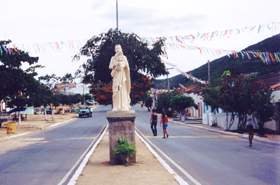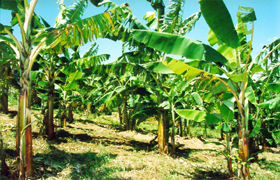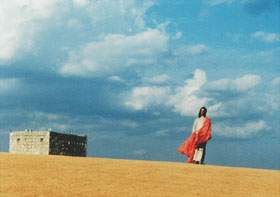|
|
Brejo da Madre de Deus - Pernambuco
«Recife
« Cities of Pernambuco
Population: 38.109 inhabitants (Census 2000)
Distance from Recife: 199 km
Accesses: PE-145, BR-104 and BR-232. Visit also maps of Recife and Pernambuco
History
The exotic name, even by Brazilian standards, literally means Swamp of the Mother of God.
The name "Brejo" (Swamp) comes from the location of the city, built deep in a valley; the trapped humidity, in the middle of a semi-arid zone, is enough to give the label of Swamp to the region. Madre de Deus (Mother of God) comes from the name given to an old mental hospital, founded in the city by priests congregated to the Brotherhood of São Felipe Neri.
 The municipality comprehends the head district, the district of Fazenda Nova and the villages of Tambor de Cima, Tambor de Baixo, Caldeirões, Fazenda Velha, Cavalo Russo, Cacimba de Pedra e Astrago.
The municipality comprehends the head district, the district of Fazenda Nova and the villages of Tambor de Cima, Tambor de Baixo, Caldeirões, Fazenda Velha, Cavalo Russo, Cacimba de Pedra e Astrago.
On May 26th, Brejo da Madre de Deus celebrates it`s political emancipation. The Saint of the city it is São José.
Economy
 The economy of the city is founded on tourism and rudimentar agribusiness.
The economy of the city is founded on tourism and rudimentar agribusiness.
A good number of tourists are attracted by the handicrafts produced in Brejo; this sector generates businesses all over the year. However, the economy has a significant boost in April of May of each year, when the open air theater of Nova Jerusalém stages a famous play of the Passion of Christ; even though the event lasts for less than ten days (during which all hotels and restaurants in town are full), it takes a few months of preparation, which provides temporary jobs for many families.
The temperature is mild (about 25ºC in the swamped areas), which favour the culture of vegetables and fruits, as bananas (photo), passion fruit, cashew fruit, mango, jack fruit, guava, papaya and avocado.
The city of Brejo da Madre de Deus is part of the Region of the Central Agreste (see map of Pernambuco), located in the Mesoregion of the Pernambuco Agreste. With an area of 10.117 km², the region embraces 10,22% of the State territory and it is constituted by another 25 municipal districts: Agrestina, Alagoinha, Altinho, Barra de Guabiraba, Belo Jardim, Bezerros, Bonito, Cachoeirinha, Camocim de São Félix, Caruaru, Cupira, Gravatá, Ibirajuba, Jataúba, Lagoa dos Gatos, Panelas, Pesqueira, Poção, Riacho das Almas, Sairé, Sanharó, São Bento do Una, São Caetano, São Joaquim do Monte and Tacaimbó.
Tourism
During the Holy Week, thousands of people from everywhere in the country invade Brejo da Madre de Deus to watch the play of the Paixão de Cristo (The Passion of Christ - see picture), played in the biggest open air theatre in the world; although this play may have got some publicity in the past few years thanks to the participation of some famous actors in the cast, it had been played continuosly for more than 50 years. 
Every year, more than 160 thousand tourists (figures of 2005), from all parts of Brazil, come to watch to the monumental play. See updated info about the event at the Nova Jerusalém official site.
During the remaining of the year (when the play is not being staged), tourists still visit the theater-city, curious to see the scenery, a nearly perfect copy of the Holy Land.
Other attractions of the city are the archeologistic cemitery of the Furna do Estrago, the rupestre inscriptions of the Pedra da Lua (Moon's Rock) and the Museu Histórico (Historic Museum).
To the ecological tourism lovers, a good suggestion is to take a walk to the Pedra do Cachorro (Dog's Rock).
In the Serra da Prata (Silver Chain - altitude of 936 meters), visitors may apreciate a look of the city; at Serra do Ponto (Point Chain - 1.195 meters), many trails challenge trekkers.
The local handicraft it is also appreciated by visitors, especially the works in dry grass and laces.dry grass' pieces and the renaissance lace goods.
It's also worth visiting the Parque das Esculturas (Sculptures' Park), with statues that represent characters of the Northeast Region of Brazil, such as the lavrador com a enxada (farmhand with his hoe), a colheiteira de algodão (the cotton's harvest woman), a mulher rendeira (lace making woman), o beato (the over-pious), o sanfoneiro (the accordion player), among others.
Source of information: IBGE and Government of the State of Pernambuco
Pictures credits: Government of the State of Pernambuco
|
|